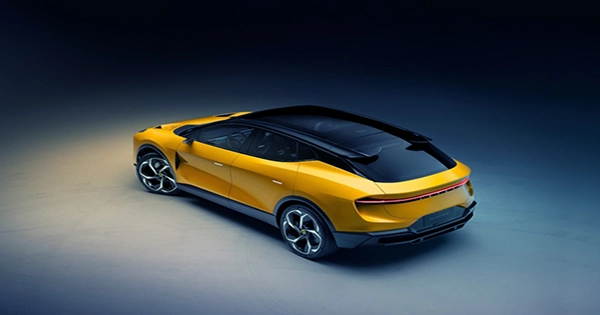The Eletre, a battery-electric “hyper” SUV, was presented by Lotus on Tuesday, the first of a trio of EVs Lotus aims to release over the next four years. What’s the bottom line? The Eletre, which translates to “coming to life,” is the British brand’s first utility vehicle and a key player in the expected surge in demand for battery-electric luxury SUVs. The design and luxurious interior amenities of the car are noteworthy. The vehicle’s technology, which includes a staggering four lidar sensors that pop out when needed, offers the greatest peek of what Lotus has planned for the future.
First, let’s go through the fundamentals. The firm is owned by Geely Automotive and Etika Automotive, a Malaysian corporation. It has enough of power, torque, and battery range. The Eletre’s electric design is 800 volts, allowing for rapid charging without battery deterioration. Two electric motors, one on each axle, provide a minimum of 600 horsepower and allow the SUV to accelerate from zero to sixty miles per hour in less than three seconds. The Eletre will be able to drive 373 miles on a full charge under the European WLTP cycle, according to Lotus, thanks to its battery pack, which will contain more than 100 kilowatts of capacity. In 20 minutes, a 350-kilowatt charger can add 248 miles.
The Eletre has four driving modes, one of which is for off-road use, that change the steering, damper settings, engine, and accelerator pedal responsiveness. Optional 23-inch wheels, active ride height, active rear-axle steering, an active anti-roll bar, and torque vectoring through braking are among the hardware and functions that may be installed. Lotus’ new factory in Wuhan, China, will start producing the car later this year.
According to Lotus Cars managing director Matt Windle, the new model “heralds a monumental juncture in our history and a clear statement of our continued determination to restructure our business.” Of course, the goal is for this watershed moment in history to result in watershed profits in the future. Lotus did not provide pricing information for the Eletre, making it difficult to determine its competitors with precision. It might compete with the Tesla Model X or some of the more upmarket SUVs that are top-sellers for luxury companies like Lamborghini and Aston Martin, depending on its pricing.
There’s an ever-growing list of possible rivals. Maserati revealed plans to debut two all-electric SUVs last week: a battery-powered version of its Levante midsize SUV and the Grecale, a brand-new tiny crossover. The $300,000 Purosangue, Ferrari’s first SUV, is arriving later this year. Lotus has “future-proofed” the Eletre by including sensors and other hardware that can be enabled via over-the-air software upgrades to improve or add functions to the advanced driver assistance system.
Automakers like as Mercedes-Benz, Volvo, and now Lotus are beginning to embrace Lidar, the light detection and ranging sensor that is widely regarded as the key to securely deploying autonomous vehicles. Lidar is seen as an essential sensor by these manufacturers to offer redundancy for specialized and limited autonomous driving characteristics, rather than complete autonomy. Not yet, at least. Lotus appears to be planning to employ lidar in the Eletre in this manner. Lotus intends to employ four lidar sensors that may be “deployed” or “popped out” as needed. When not in use, the lidar sensors are hidden, “only emerge from the top of the windscreen, the top of the back glass, and the front wheel arches as necessary,” according to Lotus.
This lidar sensor technology will ultimately allow the car to enter and exit parking spaces using a smartphone application. However, statements from Maximilian Szwaj, vice president of Lotus Technology and managing director of the Lotus Tech Innovation Center in Germany, reveal that the corporation is considering options other than parking. “As we go into a more autonomous age, ADAS technologies like as LIDAR sensors and cameras will become increasingly widespread on new automobiles,” he said in a statement, adding that the car has technology for today and tomorrow.
The car will also include a camera-based mirror system, which is currently illegal in the United States. The three cameras are for the rear-view mirror, a 360-degree picture of the car from above to ease parking, and an advanced driver assistance system. The cameras operate in concert with the lidar technology to provide “autonomous driving capabilities,” according to Lotus. Lotus does not elaborate on what “autonomous driving capabilities” entails beyond its parking ambitions. Though the technology Lotus presents is cutting-edge, there are other obstacles to overcome before a car can have effective and safe autonomous driving capabilities, including a system with sufficient computing power and software, as well as an intuitive user experience.
However, the presence of four lidar sensors and three cameras implies that the company’s ambitions go beyond restricted or conditional autonomous driving. Porosity, or the notion of air flowing through, under, over, and around the automobile for greater aerodynamics, range, and economy, is one of the company’s other breakthroughs. When designing the Evija hypercar and the Emira, Lotus leaned heavily on porosity. Eletre now owns it, indicating that this design breakthrough is here to stay. The lower grille, front fenders, and near the taillights are some of the most visible instances of these air channels.















